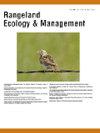高原鼠兔穴居对高寒草甸生态系统多功能性的阈值及驱动机制
IF 2.4
3区 环境科学与生态学
Q2 ECOLOGY
引用次数: 0
摘要
高原鼠兔(Ochotona curzoniae)的活动显著影响高寒草甸生态系统的功能和服务,但鼠兔的穴居如何影响生态系统的多功能性及其驱动因素还有待进一步研究。在这里,我们使用各种方法,包括实地调查、实验室分析和模型方法,评估了生态系统多功能性对鼠兔穴居活动承载水平的响应。我们的研究表明,生态系统多功能评估在确定鼠兔最佳挖洞阈值方面的重要性和可靠性超过了个体指标的效用。具体来说,维持低水平的鼠兔穴居干扰对保护多种生态系统功能至关重要。鼠兔穴居密度分别为780和730个/公顷时,生态系统的多功能性和物种丰富度达到峰值。鼠兔洞密度对生态系统多功能性影响的临界阈值(由正向负过渡)约为1500个/公顷。结构方程模型表明,在鼠兔低穴居条件下,地下生态系统功能主要形成生态系统的多功能性。相反,在鼠兔高穴居条件下,生态系统的多功能性通过改变物种丰富度和土壤温度来调节。这些研究结果为评价高原鼠兔穴居活动与生态系统功能的关系提供了更广阔的视角,为制定合理的高寒草甸生态系统鼠鼠控制策略提供了依据。本文章由计算机程序翻译,如有差异,请以英文原文为准。
Thresholds and Driving Mechanisms of Plateau Pika Burrowing on Ecosystem Multifunctionality in Alpine Meadows
The activities of plateau pika (Ochotona curzoniae) significantly influence ecosystem functions and services in alpine meadow, yet further investigation is required to explore how pika burrowing impacts the ecosystem multifunctionality and its underlying drivers. Here, we evaluated the response of ecosystem multifunctionality to carrying levels of pika burrowing activity using various methodologies, including field surveys, laboratory analyses, and model approaches. Our study demonstrated that the criticality and reliability of ecosystem multifunctionality assessment in determining optimal pika burrowing thresholds surpass the utility of individual indicators. Specifically, maintaining low levels of pika burrowing disturbance emerges as essential for preserving multiple ecosystem functions. We observed that ecosystem multifunctionality and species richness peaked when pika burrowing densities were approximately 780 and 730 burrows per hectare, respectively. The critical threshold of pika burrowing density impacting ecosystem multifunctionality (transitioning from positive to negative) was identified at around 1 500 burrows per hectare. Structural equation models revealed that under low pika burrowing conditions, belowground ecosystem functions predominantly shaped ecosystem multifunctionality. Conversely, under high pika burrowing conditions, ecosystem multifunctionality was regulated by altering species richness and soil temperature. These findings put forward a broader insight into evaluating the relationship between ecosystem functions and plateau pika burrowing activities, offering a basis for developing reasonable ecological management strategies for rodent control in alpine meadow ecosystems.
求助全文
通过发布文献求助,成功后即可免费获取论文全文。
去求助
来源期刊

Rangeland Ecology & Management
农林科学-环境科学
CiteScore
4.60
自引率
13.00%
发文量
87
审稿时长
12-24 weeks
期刊介绍:
Rangeland Ecology & Management publishes all topics-including ecology, management, socioeconomic and policy-pertaining to global rangelands. The journal''s mission is to inform academics, ecosystem managers and policy makers of science-based information to promote sound rangeland stewardship. Author submissions are published in five manuscript categories: original research papers, high-profile forum topics, concept syntheses, as well as research and technical notes.
Rangelands represent approximately 50% of the Earth''s land area and provision multiple ecosystem services for large human populations. This expansive and diverse land area functions as coupled human-ecological systems. Knowledge of both social and biophysical system components and their interactions represent the foundation for informed rangeland stewardship. Rangeland Ecology & Management uniquely integrates information from multiple system components to address current and pending challenges confronting global rangelands.
 求助内容:
求助内容: 应助结果提醒方式:
应助结果提醒方式:


